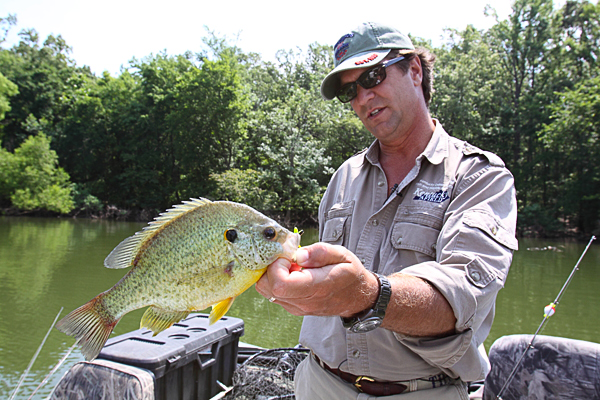By Lee McClellan

FRANKFORT, Ky. – It is a ritual as regular as the Kentucky Derby running on the first Saturday in May.
Cheesy informercials on late night television promote the newest “revolution” in fishing, usually a gimmick that appeals to the sensibilities of the sleep deprived. Some come with lights or have little motors to impart action on the lure or some innovation that usually doesn’t catch fish. Does anyone actually fish the Banjo Minnow anymore? The Helicopter lure? The Dancing Eel? The Flying Lure, designed to bounce down and under ledges to hiding fish that instead found hiding rock piles or stumps and got hung and lost on the first cast, every time? No, they don’t.
In this blur of these ever-changing fads, the one constant since the Nixon White House is the curly-tailed grub, rated by Field and Stream magazine a few years ago as the greatest lure of all time. It is not a gimmick. To a predator fish, the curly-tailed grub looks just like a baitfish swimming in the water.
Mister Twister invented the curly-tailed grub in 1972. Most plastic lures up to that time possessed little action on the retrieve, but Mister Twister made a mold where they attached a flap of soft plastic shaped like a sickle to a length of ringed plastic. The sickle-shaped tail fluttered with the slightest movement and fish went crazy for them.
Although most popular for black bass fishing, curly-tailed grubs catch crappie, bluegill, redear sunfish, hybrid, striped and white bass; practically every predator fish that swims in fresh or salt water will strike a grub.
Summer’s here and the time is right for fishing curly-tailed grubs.
A 3-inch black, pumpkinseed or smoke-colored grub works wonders on summertime stream smallmouth bass. Fish grubs on a 1/8-ounce leadhead above and below riffles by letting the lure drift in the current and occasionally ticking bottom. Resist the urge to work the lure; allow the current to do it instead. Summer smallmouth bass in streams often ignore lures like crankbaits that fly by or soft-plastic lures worked erratically. They look like frauds.
A curly-tailed grub tumbling by their noses with the tail slowly undulating in the current draws strikes, even during the hottest months and the lowest water conditions. It is hard to find a more effective lure for this situation.
When largemouth bass in lakes get a little sleepy during the hot summer days, a 4-inch black, junebug or green pumpkin curly-tailed grub may wake them up enough to strike. Rig the grub weedless on a leadhead and slowly work it along deep weed lines, just above channel drops and down points.
Lethargic largemouth bass that refused other offerings strike grubs in summer. Their subtle action and streamlined profile appeal to heat-stressed largemouth bass that don’t feel like doing much to eat during the day. A little grub swimming by is often too much to resist.
A small 1 ½-inch yellow, chartreuse, white or red grub rigged on a 1/32-ounce leadhead is a killer for big “bull” bluegills and redear sunfish, commonly called shellcrackers, in summer. Work these grubs beside and through cuts in weed beds in summer for these fish. Some anglers tip them with wax worms or organic wax worm imitations for better effectiveness.
Fishing grubs for sunfish targets the big ones, so you won’t catch as many as with other methods. For numbers of summer sunfish, try crickets or redworms suspended under a bobber.
Hybrid striped and striped bass in tailraces below dams on the Ohio River and major reservoirs hit 5- to 6-inch white or chartreuse curly-tailed grubs rigged on a ½-ounce leadheads. Fish these lures in the frothy water that has plenty of current. Striped and hybrid striped bass rip through schools of shad that congregate below these dams. The curly-tailed grub with its undulating tail looks just like a shad. Fish them in current seams where boiling water meets slack.
The curly-tailed grub also works wonders on schooling white bass during their spring runs.
Crappie hit smaller 1 ½-inch to 2 ½-inch curly-tailed grubs in blue, lime-green, yellow and white in summer. Crappie move deeper in May after they spawn and stay there all summer long. They locate on brush and submerged trees on channel drops or offshore humps in 12 to 25 feet of water. A curly-tailed grub swum just over this cover draws strikes from crappie.
The lowly, overlooked curly-tailed grub is one of the best fish catchers of all time. When the fish ignore everything else in the tackle box on those tough fishing summer days, tie on a grub and start catching, not sweating.
Author Lee McClellan is an award-winning associate editor for Kentucky Afield magazine, the official publication of the Kentucky Department of Fish and Wildlife Resources. He is a life-long hunter and angler, with a passion for smallmouth bass fishing.
-30-
The Kentucky Department of Fish and Wildlife Resources manages, regulates, enforces and promotes responsible use of all fish and wildlife species, their habitats, public wildlife areas and waterways for the benefit of those resources and for public enjoyment. Kentucky Fish and Wildlife is an agency of the Tourism, Arts and Heritage Cabinet. For more information on the department, visit our website at fw.ky.gov.


Be the first to comment